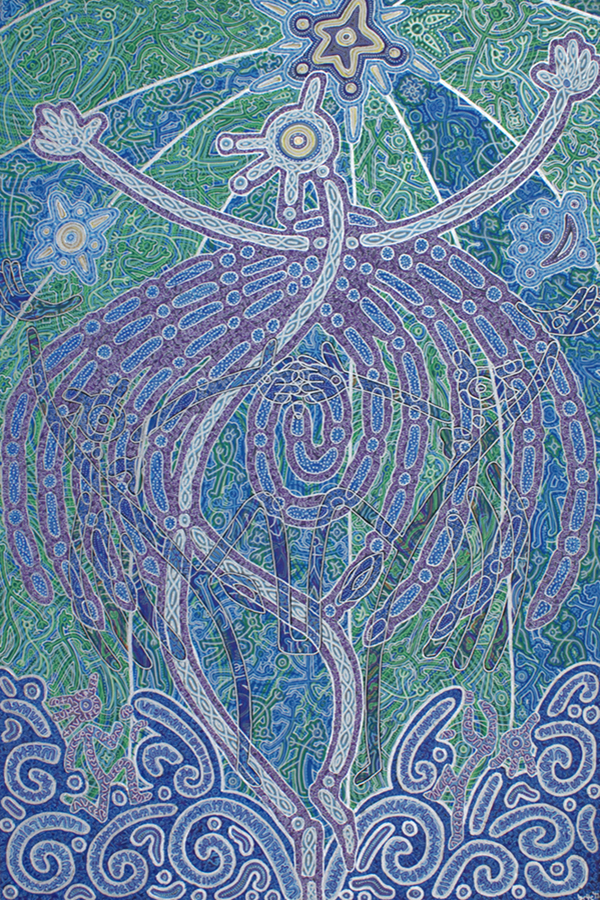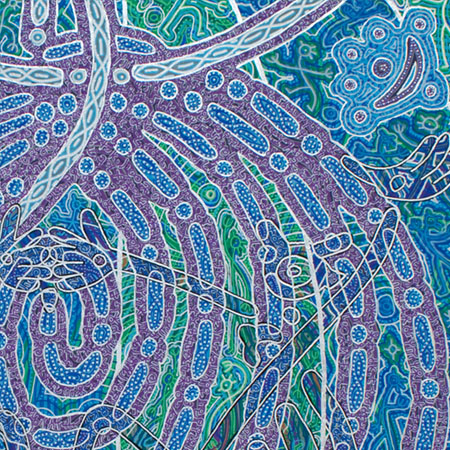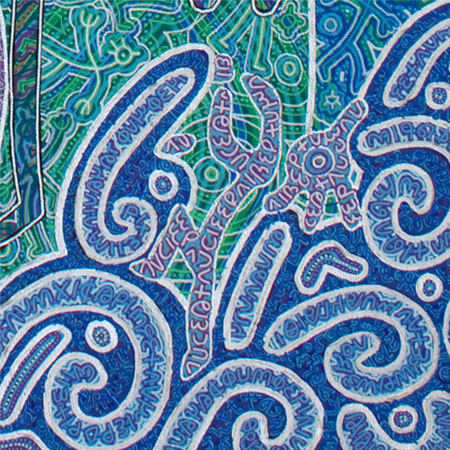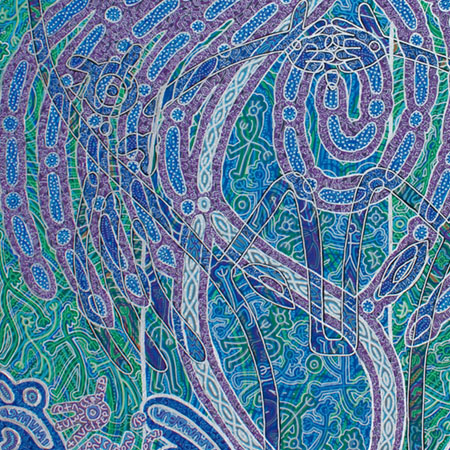:: 2012 :: 50cm x 75cm :: Acrylics, Inks and Markers on Canvas ::
:: Partially completed live at Glade Festival, UK, 16th-19th June 2012 ::
When we are faced with a mythical archetype, we behold not a single, unified, monolithic form but a liquid mandala of experiences and energies connected in a variety of ways to similar images both within the given religious culture and those foreign to the tradition. Into such archetypes are also often enfolded avatars of historical and prehistorical traditions, such that most archetypes, and indeed most myths, can be viewed in much the same way as one might view an archaeological site – deeply layered with memories from bygone ages.
Most of the world's pre-modern religious traditions acknowledge such cross-cultural linkages and remembrances – we might think here of the Romans identifying their Mercury with Greek Hermes and Egyptian Thoth – but many of the scriptural religions such as Christianity are more reticent, insisting on the uniqueness of their archetypal images and often resorting to increasingly absurd lines of reasoning in order to preserve such views. But Christian images are no less susceptible to archetypal shapeshifting and historical enfoldments than any other tradition, and the image of Lucifer is an excellent example of this.

Lucifer – the Light Bringer, the Morningstar – has long been conflated with Satan, the Lord of Hell in Christian mythology, but his origins are somewhat different. In Canaanite mythology we have the story of Attar, who attempts to mount the throne of Ba'al but is refused and so descends into the Underworld. As an avatar of Venus, this story has resonance with Inanna-Ishtar who was also sometimes represented as the Morningstar, and Astarte (the Canaanite Ishtar) was sometimes listed as his consort.
We can note here some evidence of the disappearing goddess, in that the planet Venus now is represented as a young, beautiful male rather than a female deity, and here is perhaps partly the reason for Lucifer's denigration. It is common for a later religious tradition to denigrate the principal images of a previous one, and Lucifer's consortship with a former Great Goddess would surely have offended the emerging monotheistic, and heavily patriarchal Judaeo-Christian system. We may also find here a more subtle reason for Lucifer's failure to bow down to God and Man in the First Days.
We see in Classical Greek tradition that while Venus was a beautiful, sexual woman (in common with many Mediterranean and Middle Eastern tradition), a second mytheme also existed which, judging by the names of the deities involved, was thoroughly Indo-European. This is the tradition that Eos, goddess of the dawn, had two sons by different fathers, the elder being Phosphoros – Light Bringer – and the younger being Hesperos – Evening – the father of the Hesperides, nymphs who tend the paradisical garden in the far west of the world.

Lucifer - detail of background dancing figures, upper left
A parallel tradition, more fragmentary than the Greek, appears to have been preserved among the Canaanites, with Attar as the Morning Star and the deity Shalim as the Evening Star, both nursed by the goddess Asherah as their mother, and it is widely believed that the second element in the name Jerusalem preserves the name of this god. Here, then, we perhaps have the remembrance of the identification of the 'god of Jerusalem' with the Evening Star, and thus, Lucifer's refusal to bow to his younger brother perhaps now makes more sense than a moral tale of hubris.
What can we make of this shifting mytheme, then? We seem to have an ancient, perhaps Bronze Age, image of Venus as a goddess uncompromising in her sexuality, replaced with parallel Semitic and Indo-European traditions of her two sons, twinned as the avatars of rising and falling light. But as we move into the early-modern era, the picture becomes stranger still.
We see in Revelations, chapter 22, several explicit identifications of Phosphoros with Christ – a most shocking identification in the context of Lucifer as Satan: 'I Jesus have sent mine angel to testify unto you these things in the churches. I am the root and the offspring of David, and the bright and morning star...'
...and again in chapter 2: 'And I will give him the morning star. He that hath an ear, let him hear what the Spirit saith unto the churches...'
...or in the second letter of Peter: '...whereunto ye do well that ye take heed, as unto a light that shines in a dark place, until the day dawn, and Morning Star arise in your hearts...'

Lucifer - detail of wings and the Goddess bearing the Moon
This is striking stuff – the long-denigrated Lucifer is now elevated as an avatar of Christ, and not just metaphorically. It is no wonder that artists, poets and seers have been so drawn to Lucifer – there is something transcendent here, beyond merely the Satanic or the Christlike. This mercurial figure hints at a world of images beyond such dualities.
We should remark here that the identification of Lucifer with Christ does have some eschatological sense. Just as Adam's all-too-human fall from grace could only be resolved by Jesus' all-too-human penance on the cross, so Lucifer's similar fall could only be resolved through the god Christ's resurrection and re-emergence from the Underworld. Both mortal and immortal worlds were thus, in theory, restored to balance and favour. In a sense too, the image of Jesus Christ attempts to unite the two brothers into one.
But just as a meditative, distant Father God soon had to resurrect Zeus's lightning bolts in order to impose Church authority in the post-pagan Roman era, so Lucifer had to be enfolded back into the Underworld in order for the dualist Christianity to persist and grow. We have here perhaps elements of a hidden mystical tradition, one perhaps not entirely Gnostic nor Catholic but of an esoteric or eschatological kind.

Lucifer - detail of lower right revealing figure and the oceanic text
So we arrive at our contemporary era, with the whispers of Lucifer still carried upon Christ's dominant breeze, but something has now fundamentally changed, for we are witness to the re-emergence of the Divine Feminine into our archetypal lives, and as such, we find ourselves gazing at a new religious culture which, in some ways, bears striking resemblance to the picture anciently current in the Neolithic and Bronze Ages: the Goddess and her two sons. As such, an older order of perception can again begin to take hold – that of Lucifer not as prideful or against man, but simply as his name suggests – the Light Bringer.
There will be of course objections to this – but I remain convinced that the much-maligned Lucifer must emerge. It is noteworthy that the only global tradition to denigrate serpents – long a transcendent symbol of the interplay of life, death and rebirth – which has also turned the Greek word δαιμων 'dynamic of life, principle of life' into demon, devil, also denigrates an image of transcendence that bears the name 'Light-Bringer', and it is this kind of light beyond dualities that is essential for the continued wellness of our steadily-falling world.

Lucifer - detail of serpentine body form and the interaction of wings with background figures
Luceat Lucifer Libertum – Shine Lucifer Free
I have depicted Lucifer here in distinctly serpentine form, in a style which as much harks back to Neolithic petroglyphs as it does forward to contemporary design, additionally enfolded with lineforms which suggest the opening and closing of portals as much as genetic structure. His former avatars – Morning and Evening Stars – pull back the waters of Ocean to see him fly up with wings outstretched to reach for the glowing star portal which marks our transition into a new world beyond duality.
Shimmering underneath him are two mirrored goddesses holding aloft the Sun and the Moon – more dualities which he is seeking to surpass. These represent memories of his mother Asherah and his consort Astarte. But just as he transcends the dual male, he transcends the dual female also: the memories of his once being a female image of Venus mark him as being somewhat Queer perhaps, but ultimately transcendent of all forms of gender.
Lucifer here, shorn of all worldly and temporal images of gender and history, begins a dance simultaneously seductive and transpersonal that forms the bones of animation of a new world. All around him, similar figures dance – each of us has our own Lucifer Within whose dance of creation must now emerge.

Lucifer - deyail of background dancing figures, upper right
Luceat Lucifer Libertum – Shine Lucifer Free
This artwork has become a developmental piece for me. Partially completed as part of a Live Art performance at Glade Festival, I wanted to see how Neolithic petroglyphs and modern typographic design might sit together in a visionary context, and as the piece evolved into ever further detail, a kind of Luciferian Manifesto emerged into my consciousness.
The background is covered with waveforms overlaid with dancing figures of several colours, while the wings, ocean waves and twin figures are enfolded with textual and typographic forms from my two neographies. In some ways, the style here represents a summary of a variety of techniques I have been exploring for several years, but equally the detailed combinations of such techniques mark a beautiful way forward for the future. The resultant image contains a deep complexity of colour and is probably the most complete expression of joy and constantly-flowing movement I have ever achieved.









